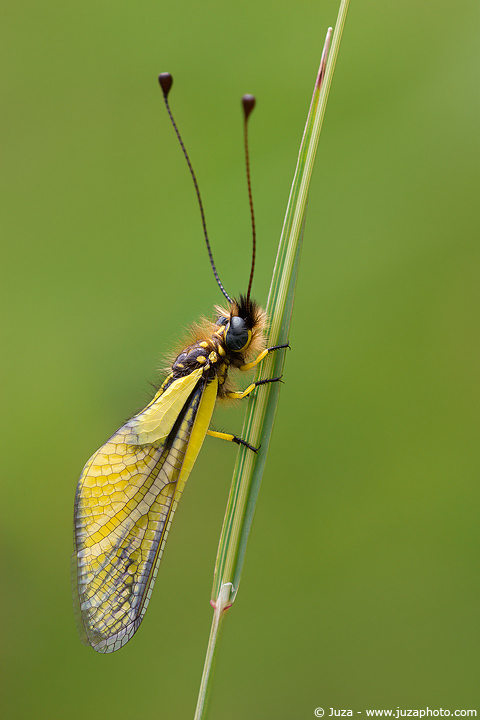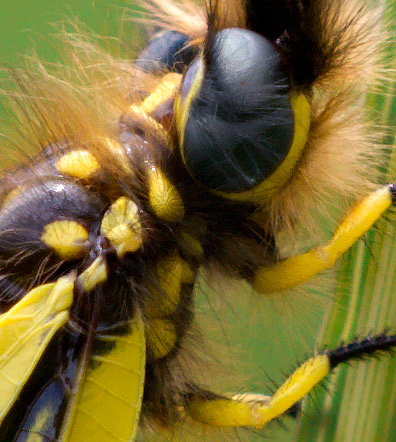[/url]
A 100% crop from the processed photo. Click to view a wider crop. I mounted the lens on the small Manfrotto 190MF4 tripod and I carefully focussed on the eye, using the Canon Angle-Finder C at 2.5x magnification. Focussing with the 180 + 2x is much more difficult than focussing with the bare lens: the viewfinder is 2 stops darker, and there is a wider depth of field (f/7.1 vs f/3.5) that makes more difficult to focus exactly in the right spot. Moreover, every little movement of the focus ring makes an huge difference - you have to be very careful, to make precise adjustments. The is not autofocus so you have to rely exclusively on you eye and your manual focus technique.
There was a little of wind, so I set the camera on ISO 400, and I choose the aperture f/11. Usually I prefer to stop down to f/16 for some more depth of field and for the maximum sharpness, but here, other than the wind, the subject was quite close to the background, and at f/16 it wouldn't have been possible to get the separation from background that you see in this photo. Of course, I placed the camera as much parallel as possible to the subject, to optimize the depth of field.
As usual, I've taken many shots to be sure that at least one photo turned out as sharp as I want; I used mirror lock up and remote release to avoid camera shake. The focal length of 360mm makes this lens very prone to vibrations - if you don't get satisfying results from the Sigma 180 + 2x, it is very likely that either you didn't focus precisely or you didn't use a good support and good sharpness techniques (release and MLU).
As I already said, one of the advantages of teleconverters is increased working distance. The following table shows how focussing distance (the distance from the subject to the sensor) and working distance (the distance from the front element or the hood and the subject) are influenced by 1.4x and 2.0x TCs.
Focal Length: 180mm
Focusing distance at 1:1: 46.0 centimeters
Working distance (no hood): 23.8 centimeters
Working distance (with hood): 15.9 centimeters
Focal Length: 250mm (180 + 1.4x)
Focusing distance at 1:1: 54.0 centimeters
Working distance (no hood): 30.1 centimeters
Working distance (with hood): 22.2 centimeters
Focal Length: 360mm (180 + 2.0x)
Focusing distance at 1:1: 64.5 centimeters
Working distance (no hood): 37.3 centimeters
Working distance (with hood): 29.4 centimeters
You may thing that a 2x TC doubles the focussing distance, but this is not the case with macro lenses. With the Sigma 180, the focussing distance at 1:1 goes from 46cm to 64cm - a big improvement, but not twice. The reason of this weird behaviour is that the lens changes its focal length at the narrowest distances, to achieve 1:1 magnification without changing its phisical length. At close distances the 180mm is not an actual 180, but it is somewhere between 80 and 140mm (this behaviour is not a peculiarity of the 180 - nearly at macro lenses reduce their focal length to achieve the hightest magnifications). On the other hand, in practice the working distance (from the subject to the end of the lens hood) is almost dubled, from 15.9 centimeters to 29.4 centimeters - and this is an huge improvement, that makes much easier to photograph shy bugs.
Other than working distance, the 2.0x teleconverter improves the background blur: the longer focal has a narrower angle of view so, even though depth of field is the same, a 360mm gives a more uniform background than a 180mm. The longer focal length does not guarantee always clean backgrounds: if the subject is close to the background, there is not much difference between 180 and 360. With small subjects, or with relatively distant backgounds, instead, there is a noticeable difference between 180 and 360mm, without a big loss of image quality.
Replies and comments
What do you think about this article?
Do you want to tell your opinion, ask questions to the author, or simply congratulate on a particularly interesting article? You can join the discussion by joining JuzaPhoto, it is easy and free!
There is more: by registering you can create your personal page, publish photos, receive comments, join discussions and you can use all the features of JuzaPhoto. With more than 257000 members, there is space for everyone, from the beginner to the professional.



 JuzaPhoto contains affiliate links from Amazon and Ebay and JuzaPhoto earn a commission in case of purchase through affiliate links.
JuzaPhoto contains affiliate links from Amazon and Ebay and JuzaPhoto earn a commission in case of purchase through affiliate links.